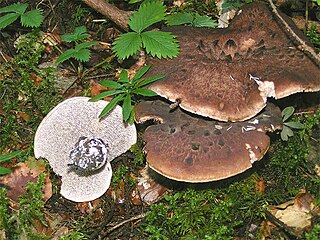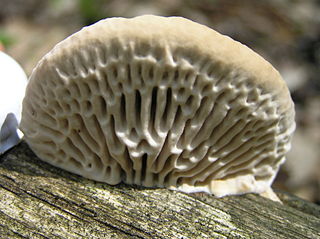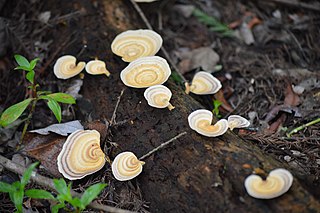Edred John Henry Corner FRS was an English mycologist and botanist who occupied the posts of assistant director at the Singapore Botanic Gardens (1929–1946) and Professor of Tropical Botany at the University of Cambridge (1965–1973). Corner was a Fellow of Sidney Sussex College from 1959.

The Thelephorales are an order of fungi in the class Agaricomycetes. The order includes corticioid and hydnoid fungi, together with a few polypores and clavarioid species. Most fungi within the Thelephorales are ectomycorrhizal. None is of any great economic importance, though Sarcodon imbricatus is edible and commercially marketed, whilst several species have been used for craft dyeing.

Turbinellus floccosus, commonly known as the scaly vase, or sometimes the shaggy, scaly, or woolly chanterelle, is a cantharelloid mushroom of the family Gomphaceae native to Asia and North America. It was known as Gomphus floccosus until 2011, when it was found to be only distantly related to the genus's type species, G. clavatus. It was consequently transferred from Gomphus to Turbinellus. The orange-capped vase- or trumpet-shaped fruiting bodies may reach 30 cm (12 in) high and 30 cm (12 in) wide. The lower surface, the hymenium, is covered in wrinkles and ridges rather than gills or pores, and is pale buff or yellowish to whitish.

Daedalea is a genus of fungi in the family Fomitopsidaceae. The genus was circumscribed in 1801 by mycologist Christian Hendrik Persoon, based on the type D. quercina and four other species. The generic name is derived from the Ancient Greek δαιδαλεος.

Boletellus is a genus of fungi in the family Boletaceae. The genus has a widespread distribution, especially in subtropical regions, and contains about 50 species. The genus was first described by American mycologist William Alphonso Murrill in 1909. The genus name means "small Boletus".

Gloeoporus is a genus of crust fungi in the family Irpicaceae. The genus has a widespread distribution.

Hygrophoropsis is a genus of gilled fungi in the family Hygrophoropsidaceae. It was circumscribed in 1888 to contain the type species, H. aurantiaca, a widespread fungus that, based on its appearance, has been affiliated with Cantharellus, Clitocybe, and Paxillus. Modern molecular phylogenetic analysis shows that the genus belongs to the suborder Coniophorineae of the order Boletales.

Ramariopsis kunzei is an edible species of coral fungi in the family Clavariaceae, and the type species of the genus Ramariopsis. It is commonly known as white coral because of the branched structure of the fruit bodies that resemble marine coral. The fruit bodies are up to 5 cm (2.0 in) tall by 4 cm (1.6 in) wide, with numerous branches originating from a short rudimentary stem. The branches are one to two millimeters thick, smooth, and white, sometimes with yellowish tips in age. Ramariopsis kunzei has a widespread distribution, and is found in North America, Europe, Asia, and Australia.

Ischnoderma is a genus of polypore fungi. Species in the genus have dark brown and tomentose fruit bodies that become darker brown to black and smooth when mature. The genus, widespread in temperate regions, contains an estimated 10 species.

Amauroderma is a genus of polypore fungi in the family Ganodermataceae. The genus, widespread in tropical areas, contains about 70 species. Amauroderma fungi are wood-decay fungi that feed and fruit on decayed branches and trunks.

Microporellus is a genus of poroid fungi in the family Polyporaceae.

Marasmius rotula is a common species of agaric fungus in the family Marasmiaceae. Widespread in the Northern Hemisphere, it is commonly known variously as the pinwheel mushroom, the pinwheel marasmius, the little wheel, the collared parachute, or the horse hair fungus. The type species of the genus Marasmius, M. rotula was first described scientifically in 1772 by mycologist Giovanni Antonio Scopoli and assigned its current name in 1838 by Elias Fries.
Dictyonema is a genus of mainly tropical basidiolichens in the family Hygrophoraceae.
Parastereopsis is a genus of fungi in the family Cantharellaceae. It is a monotypic genus, and contains one species, Parastereopsis borneensis, described as new to science by British mycologist E.J.H. Corner in 1976.

Thelephora palmata is a species of clavarioid fungus in the family Thelephoraceae. The fruit bodies are leathery and coral-like, with branches that are narrow at the base before widening out like a fan and splitting into numerous flattened prongs. The wedge-like tips are whitish when young, but darken as the fungus matures. The common names of the fungus refers to its pungent odor, likened to fetid garlic. A widely distributed but uncommon species, it is found in Asia, Australia, Europe, North America, and South America, where it fruits on the ground in both coniferous and mixed forest.
Clarkeinda trachodes is a poisonous mushroom in the family Agaricaceae. This agaric species is only distributed in South and Southeast Asia in countries such as Bangladesh, China, India, Indonesia, Malaysia, and Sri Lanka. It has both a partial and universal veil, and dark-colorer spores.

Cymatoderma caperatum is a fungus species in the family Meruliaceae. It was originally described in 1849 as a species of Thelephora by Miles Joseph Berkeley and Camille Montagne. Derek Reid transferred it to Cymatoderma in 1956.

Nigroporus vinosus is a species of poroid fungus in the family Steccherinaceae, and the type species of the genus Nigroporus. Its fruit bodies have brownish caps with tinges of purple or red. The cap underside has a pore surface the same colour as the cap, and minute pores. Nigroporus vinosus has a pantropical distribution. It has been recorded from Africa, North America, Central America, South America, Asia, and Oceania. It is a wood-decay fungus that causes a white rot.














